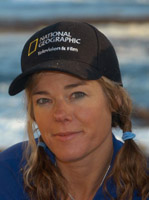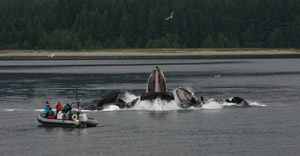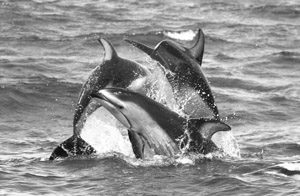November/December 2014
Mola Mola (Ocean Sunfish)

Thursday, December 4, 2014
7 p.m. Refreshments, 7:30 p.m. Program
Lecture Hall, Monterey Boatworks, Hopkins Marine Station,
Pacific Grove (Across from American Tin Cannery Outlet Stores)
Speaker: Dr. Tierney Thys, National Geographic Explorer
Dr. Tierney Thys has been studying ocean sunfish, Mola mola, for 14 years to learn about life in the open ocean. She uses satellite tags and DNA testing to track their movements and feeding patterns to understand how they thrive with their odd shape and diet comprised of mainly jellies.
She told National Geographic her fascination with mola started with a photograph she saw in graduate school. “When it comes to fishes, the mola really pushes the boundary of fish form. It seems a somewhat counterintuitive design for plying the waters of the open seas – a rather goofy design – and yet the more I learn about it, the more respect and admiration I have for it,” she explained.
Dr. Thys is a National Geographic Explorer who mentored under the pioneering Sylvia Earle, spent 10 years as director of research for Sea Studios Foundation in Monterey and became a member of the TED braintrust.
She earned her doctorate from Duke University in 1998 with a dissertation on the mechanics of swimming muscles in fish, then expanded her research and devotion to marine education. While at Sea Studios, she directed research for National Geographic’s “Strange Days on Planet Earth.”
More information is available on Dr. Thys’ Web site, www.oceansunfish.org.
Please join us for refreshments before the program begins.

October 2014
White Shark Video
Thursday, October 30, 2014
7 p.m. Refreshments, 7:30 p.m. Program
Lecture Hall, Monterey Boatworks, Hopkins Marine Station,
Pacific Grove (Across from American Tin Cannery Outlet Stores)
Speaker: Skyler Thomas, founder and videographer
Skyler Thomas established the nonprofit White Shark Video in San Francisco five years ago to help call attention to the plight of overhunted and frequently misunderstood white sharks. His motto is “turning research into film” as he swims underwater with white sharks — and more recently humpback whales — recording their movements, behaviors and feedings.
“I do think sharks are really cool,” he told a recent interviewer. “The main reason I focus on them is that I think they are in really big trouble and need people to tell their story… If everybody sees what I saw, maybe they would have a harder time killing them or holding them captive.”
Skyler’s most recent posting is an 11-minute video he posted on Animal Bytes TV in September, called “Swimming with Whales: Price of Existence.” It includes incredible underwater footage of humpback whales interacting with snorkelers, and mom and baby whales nuzzling and snuggling like they were weightless in their motion and tenderness.
He is a graduate of San Jose State University, with a bachelor’s degree in biology and a master’s in digital media.
Please join us for refreshments before the program begins.
September 2014
Humpback Whales and bubble netting
Thursday, September 25, 2014
7 p.m. Refreshments, 7:30 p.m. Program
Lecture Hall, Monterey Boatworks, Hopkins Marine Station,
Pacific Grove (Across from American Tin Cannery Outlet Stores)
Speaker: Dr. Fred Sharpe, principal investigator, Alaska Whale Foundation

In bubble netting, pods of humpbacks release columns of bubbles from their blowholes so that the rising air produces nets to corral herring for lunge feeding. Dr. Sharpe’s tenacious observations of social behavior have found not all the 3,000 humpbacks that frequent Southeast Alaska off Juneau during the summer foraging season participate in bubble netting. He has identified about 60 and assigned some names, such as Captain Hook and Melancholy.
The research has found that different individuals in the pod have different tasks, and those cooperative teams work together for decades. Underwater hydrophones have recorded singers in the pods issuing “feeding calls” to drive the prey into the waiting nets.
Dr. Sharpe earned his doctorate from Simon Fraser University in British Columbia. In his off time, he explores the hills and forests of the Pacific Northwest, recording bird calls and collecting plant specimens. He has authored two books – Birding in the San Juan Islands and Wild Plants of the San Juan Islands.
Please join us for refreshments before the program begins.
August 2014
The 2013 Year of Abundance in Monterey Bay – Anomaly, anachronism or wave of the future?
Thursday, August 28, 2014
7 p.m. Refreshments, 7:30 p.m. Program
Lecture Hall, Monterey Boatworks, Hopkins Marine Station,
Pacific Grove (Across from American Tin Cannery Outlet Stores)
Speaker: Jodi Frediani, photographer and whale researcher

Jodi will include extreme sightings, such as killer whales tossing a dolphin last year, and rarely observed leopard sharks, leatherback turtles feeding, mola mola feeding, and underappreciated krill and anchovies that feed so many other animals.
A graduate of UC Santa Cruz, Jodi has been photographing marine life in Monterey Bay for the past five years, taking time off from photographic adventures in Brazil, Antarctica, Thailand and Africa.
In addition, she has been snorkeling with the North Atlantic humpback moms and calves in Silver Bank, off the coast of the Domincan Republic, for the past 13 years and is currently in charge of collecting fluke ID data. Her underwater photos from that work were featured in a previous presentation to ACSMC, a very popular program a few years ago.
Her images have appeared in a number of publications, including The Atlantic magazine, the U.K.’s Daily Mail and Daily Telegraph, the San Jose Mercury News, Santa Cruz Sentinel, Monterey Herald, and on Wired.com and Brazil’s Veja.com.
A selection of Jodi’s marine mammal and bird photos are featured on our Photo Gallery, and more of her photos can be seen on www.jodifrediani.com.
Please join us for refreshments before the program begins.
July 2014
ACS Annual Barbecue – Cancelled
Saturday, July 26, 2014
Unfortunately, the annual barbecue was cancelled. Any payments that were already made will be returned ASAP. Please join us for the next meeting on August 28th.Questions call 831-373-4281
June 2014
Where’s Whaldo? Modeling cetacean distributions in dynamic habitats to reduce anthropogenic impacts
Thursday, June 26, 2014
7 p.m. Refreshments, 7:30 p.m. Program
Lecture Hall, Monterey Boatworks, Hopkins Marine Station,
Pacific Grove (Across from American Tin Cannery Outlet Stores)
Speaker: Dr. Karin Forney, Research biologist, Marine Mammal and Turtle Division, NOAA’s Southwest Fisheries Science Center
Dr. Karin Forney will talk to us about trying to reduce human impacts on cetaceans by modeling their distributions in dynamic habitats. NOAA has surveyed marine mammals within the California Current ecosystem since 1991 to estimate the populations and monitor trends. During the past decade, researchers have developed methods for finer scale models to assess localized impacts from naval activities, fishery bycatch, vessel traffic and energy development.
They have provided the models to the U.S. Navy and other users for assessment and mitigation of potential harm. Dr. Forney will present an overview of the process.
Dr. Forney has researched the abundance, distribution, ecology, fishery bycatch and status of more than 20 species of cetaceans and pinnipeds in the eastern and central northern Pacific Ocean for the past 27 years. She has also collaborated on studies of endangered leatherback turtles off California. Her research has been published in scientific journals and technical reports, and presented at national and international conferences.
One of her research interests is assessing and mitigating human caused mortality and injury of protected species. Dr. Forney also concentrates on ocean variability and its effects on marine mammals and other marine invertebrates, predictive models of cetacean distribution, and development of improved methods for estimating abundance.
Please join us for refreshments before the program begins.
May 2014
The Extreme Life of the Sea
(Copies of the new book will be on hand for sale and signing)
Thursday, May 29, 2014
7 p.m. Refreshments, 7:30 p.m. Program
Lecture Hall, Monterey Boatworks, Hopkins Marine Station,
Pacific Grove (Across from American Tin Cannery Outlet Stores)
Speaker: Dr. Stephen Palumbi, Director of Hopkins Marine Station
Steve Palumbi fascinated us three years ago when he spoke to the Monterey Bay Chapter about his book The Death & Life of Monterey Bay, an encouraging proof that conservation works and allows nature to recover from human abuse. Now he’s going to talk about his latest book, The Extreme Life of the Sea, which was published in February by Princeton University Press. Steve is co-author with his son, Anthony Palumbi.
One of the nation’s top marine biologists, Steve came to Stanford University’s Hopkins Marine Station from Harvard University in 2002. He earned his PhD in marine ecology at the University of Washington. His lab at Hopkins has been concentrating on corral diversity and adaption potential to climate change, environmental impacts on abalone genetics, and local adaptions in sea urchins.
His illustrated presentation to ACSMB will be about some of the most marvelous life forms on earth and the challenges they overcome to survive. There are the fastest and deepest, hottest and oldest creatures in the oceans. There were dives in the icy Arctic, explorations of the boiling hydrothermal vents and studies of the eternal darkness in the deepest trenches and the marine life that thrives there against all odds.
A review in Publishers Weekly said, in part: “Highlighting the strangest cases in animate sea life, marine ecologist S.R. Palumbi exudes a palpable and contagious sense of delight as he enlists his writer son’s help to fill the ‘gap in character development’ in the story of the ocean’s robust yet fragile ecosystems.”
Please join us for refreshments before the program begins.
April 2014
Sea Mammals: flukes are no fluke…
Thursday, April 24, 2014
7 p.m. Refreshments, 7:30 p.m. Program
Lecture Hall, Monterey Boatworks, Hopkins Marine Station,
Pacific Grove (Across from American Tin Cannery Outlet Stores)
Speaker: Milos Radakovich
Our April speaker has been cruising the world – Alaska, Hawaii, Caribbean, Mediterranean, Norway, South America, Australia/New Zealand – for the past eight years. Milos Radakovich is an on-board naturalist for Celebrity Cruises/Royal Caribbean. He was an active marine biologist and educator around Monterey Bay for 30 years before that, and well known for his programs, classes and tours.
Milos will be talking to us about cetaceans and their ancestors and the genetic revelations of the past decade or so. “We’re a long way from knowing the whole story, but more chapters are being written all the time by researchers from all over the world,” he notes. “We know the ending as of today, but the tale of how their ancestors survived and even succeeded in a medium so inherently hostile to warm-blooded air breathers is truly fascinating and not just a fluke.”
A longtime member of the American Cetacean Society, Milos was president of our chapter in 1982-83. He also helped found a marine mammal stranding team and was co-founder and director of Bay Net, the shoreline docent group of the Monterey Bay National Marine Sanctuary. Before he left the mainland for his cruising career, Milos starred on a science show on KUSP, the NPR station in Santa Cruz.
He was awarded the Association of Monterey Bay Area Governments’ Citizen Award in 1996, the Monterey Bay National Marine Sanctuary’s Educator of the Year Award in 1998, and NOAA’s Environmental Hero Award in 2001. A native of Serbia, he immigrated to the U.S. with his family when he was 11.
Please join us for refreshments before the program begins.
March 2014
The Natural History of Cephalopods
Thursday, March 27, 2014
7 p.m. Refreshments, 7:30 p.m. Program
Lecture Hall, Monterey Boatworks, Hopkins Marine Station,
Pacific Grove (Across from American Tin Cannery Outlet Stores)
Speaker: Dr. Steve Webster
Dr. Steve Webster, one of our favorite speakers, will discuss the evolution and natural history of octopuses, squid and other cephalopods, giving us a taste of a Tentacles exhibit opening in April at The Monterey Bay Aquarium.
Our presentation will include video clips and stills from Steve’s 50 years of underwater photography as well as clips from Sea Studios’ Shape of Life series on PBS’s Nature program. In addition to tropical species in Indonesia, Steve will highlight local octopuses and Humboldt squid. He’ll discuss the evolution, diversity, vision, behavior, reproduction and predation of the octopuses, squids, nautiloids and cuttlefishes.
Steve is one of the four friends who conceived the idea of an aquarium on Cannery Row and became its first project coordinator, then director of education and senior marine biologist. He was a Stanford graduate (doctoral work at Hopkins Marine Station 1965-71) teaching invertebrate zoology at San Jose State when the aquarium idea was born in 1978. Since it opened in 1984, more than 54 million people have gone in to learn about Monterey Bay and marine life. Steve retired from the Aquarium in 2004 but stays as a volunteer guide and teacher for the other volunteers and staff.
He is a past chair of the Monterey Bay National Marine Sanctuary Advisory Council and is currently on the boards of York School, the Sea Studios Foundation, the Elkhorn Slough Foundation and the Friends of Hopkins Marine Station.
Please join us for refreshments before the program begins.
February 2014
Solving California’s Water Crisis: What Role Will the Ocean Play?
Thursday, February 27, 2014
7 p.m. Refreshments, 7:30 p.m. Program
Lecture Hall, Monterey Boatworks, Hopkins Marine Station,
Pacific Grove (Across from American Tin Cannery Outlet Stores)
Speaker: Dr. Carol Reeb
We’re getting very timely this month when Dr. Carol Reeb, a fishery geneticist who is a research associate at Hopkins Marine Station, talks to us about the impacts seawater desalination can have on marine ecosystems.
Many water districts and purveyors along Monterey Bay and the entire West Coast have been planning or exploring seawater desalination as a way to supply demands for potable water that fresh water sources – and rainfall – no longer meet. Anyone who has followed the 25-year debate on the Monterey Peninsula knows the financial costs are very high, but the environmental costs are yet to be determined. They may be very high too.
Proponents say seawater desalination should have no impacts on the ocean because the brine discharged from the plants is nothing but seawater with concentrated salt that should be easily diluted after it’s returned.
But Dr. Reeb has examined 100 years of Monterey Bay records that indicate that may not be true. The salinity on the bottom has been fairly stable. Mixing in the ocean occurs at the surface, where winds whip waves – not on the sea floor where the discharge pipes go. The heavier brine can cover the seafloor like a layer of plastic wrap, suffocating all the organisms in the sand below it and, in Monterey Bay, disrupting the valuable squid nurseries.
Dr. Reeb has helped develop two new amendments to California’s Ocean Plan for seawater desalination. In addition to her work at Hopkins, Dr. Reeb developed The Water for Our Future Award to encourage young scientists to think about solving future water shortages.
Please join us for refreshments before the program begins. More information is available at Dr. Reeb’s Web site, http://www.doconmontereybay.org/.
January 2014
The Outstanding Science and Conservation of Marine Mammals
Thursday, January 30, 2014
7 p.m. Refreshments, 7:30 p.m. Program
Lecture Hall, Monterey Boatworks, Hopkins Marine Station,
Pacific Grove (Across from American Tin Cannery Outlet Stores)
Speaker: Dr. Jim Harvey, Moss Landing Marine Lab
Dr. James Harvey has been a noted researcher and educator with Moss Landing Marine Laboratories for the past 25 years. Last year he was named director of the institution, which is the marine labs and marine science graduate program for a consortium of seven California State Universities.
Jim has a wide interest in the ecology and biology of marine vertebrates and has researched, among other things, migration and diving of gray and humpback whales; foraging, diving, ecology and population dynamics of harbor seals; the ecology of Leatherback turtles; interactions between marine mammals and fisheries; and foraging, ecology and growth of blue sharks. He has studied the relationships of oceanographic conditions and marine animals, and assessed the health and conditions of marine mammals, turtles and birds.
As a professor, he has been the major advisor for 74 masters students and, currently, 11 graduate students. Jim has also published 99 scientific papers and obtained 134 research grants worth more than $6 million. He got his B.A. from San Jose State University, his masters from Moss Landing and his doctorate from Oregon State University, then conducted research at the National Marine Mammal Laboratory in Seattle on a National Resources Council fellowship before joining the staff of Moss Landing Marine Laboratories in 1989.
In the wider community, he chairs the Research Activity Panel for the Elkhorn Slough National Estuarine Research Reserve, is treasurer of the Society for Marine Mammalogy’s board of governors, serves on the San Jose State University Research Foundation, and is an advisor for the Monterey Bay National Marine Sanctuary, the National Marine Fisheries Service and the Marine Mammal Center.
Related web page: Moss Landing Marine Laboratories
